Randi Zuckerberg's Blog, page 19
May 4, 2016
Radio Recap: Mothers in the Workplace

Mother’s Day is only 4 days away so today ‘Dot Complicated with Randi Zuckerberg’ celebrated by discussing how to parlay the soft, natural leadership skills of motherhood into the hard skills of the business world with Erica Keswin—Founding Principal of Organization Performance Relationships (O.P.R.), a boutique consulting firm that works with both individuals and businesses to address ways to cultivate meaningful and productive relationships in this growing tide of digital distraction.
“We don’t want to take three steps back as women.”
“People want to connect with an actual person. You just want to hear a voice.”
“If we give a Twitter account to someone who would say interesting things and have an interesting perspective, then I could see the benefits.”
“There are always going to be people watching TV.”
“Once women decide to leave the workforce a fear of technical proficiency will stop them from going back.”
“When you re-enter the workplace think about ways your currents skills transfer into a new job.”
“Technical skills can be learned, online or at night. But the softer skills—active feedback, listening—mothers have those naturally.”
“Actively listening, putting your phone away and listening are becoming increasingly critical skills because Millennials are demanding their managers know them personally.”
“You can’t learn about an employee in an email.”
“The iPhone Effect is real study. If your phone is on the table, it makes conversation more trivial. Even if your phone is in your peripheral vision, it will have the same affect.

“Attention is currency. Just because you walk into a room does not mean people are really there.”
“We’re addicted to email, each time we get one we get a shot of dopamine. We need help managing it. We need protocol. As mother’s we establish that.”
“The softest skills are the hardest to teach and the hardest to find.”
“The issue with empathy is the impact of all this technology on it.”
“People want the people with whom they’re speaking to understand what they’re saying.”
“Match the message to the medium—many people default to a technological response.”
“It’s easier to feel empathy through social media.”
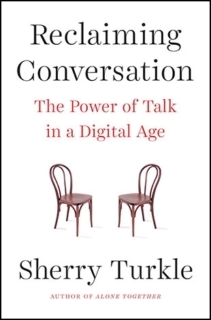
“’Reclaiming Conversation’ with Shelly Turkle helped me learn the role of communication within the workplace and how technology was affecting that.”
“Figuring out ways to connect with people in your business is great for the bottom line.”
“My interest and passion around relationships started with Barbara Reich—time management guru.”
“With technology, no one can ever be caught up, the good news is Barbara and I can show how to increase productivity and lowering stress.”
“Managing your relationships isn’t just with other people, it’s also with yourself.”
“When Warby Parker is hiring people, they hire for empathy.”
“Jeff Weiner of LinkedIn talks about ‘compassionate management.’”
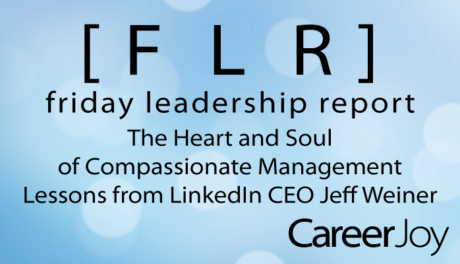
“Women who want to re-enter the workplace who realize they have empathy skills can ask how they can start the process of going back.”
“Apres Group helps women re-enter the workplace.”
“Think through the skillset you used to be successful in your different roles. Do a gap analysis.”
“Mothers are constantly juggling.”
“No one other than you is going to be able to build your network. Start with a plan.”
“I make a goal for myself to have lunch or coffee with a certain number of people to build and strengthen relationships.”
“Every time I focus and engage with other people something great comes out of it.”

“Maternity policies are starting to change. One of the challenges is the senior women in company aren’t taking leave. What messages are we sending?”
“If someone wants to be their own boss and freelance, there’s no better time than right now.”
“My advice is to decide what you want to do. Think about your strategies to build and grow the business.”
“Template your time, maybe Tuesday is business development day and Wednesday is marketing day.”
“You have to really be very disciplined and strategic about your time.”
“Work / life balance is much harder when you run your own business.”
“The negotiation skills moms have carries over well into running their own businesses.”
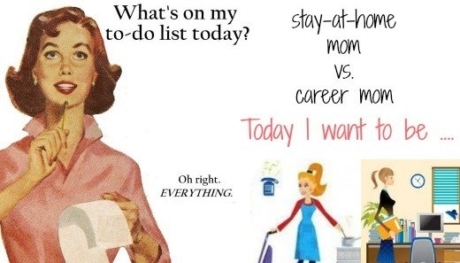
“Multi-tasking does not work for anyone. But women tend to be better at it.”
“I find reading fiction or going to the movies helps me relax. People feel guilty doing something where their mind goes somewhere else.”
“Organization and relationship building are the two traits I want to pass onto my kids.”
“My kids teach me about business every day. I can pause before reacting and responding. Taking a mom time-out.”
“The number one trend companies are trying to integrate into the workplace is working from home. Millennials are demanding it.”
“Most managers or leaders don’t have these discussions with people. Employees need to ask what the guidelines are.”
Read more about Erica Keswin HERE
Join ‘Dot Complicated with Randi Zuckerberg’ next Wednesday at 12pm ET when first female network TV founder, Kay Koplovitz, joins the show! Only on SiriusXM Business Channel 111!
Happy Mother’s Day!!

April 29, 2016
Reflections on 2016’s Take Your Sons and Daughters to Work Day

Earlier this year, former White Sox ringer, Adam LaRoche, retired from baseball—and a $13 million-dollar-a-year salary—after being told his 14-year-old son could no longer be in the locker room with him. This expensive decision brought up, once again, the impossibility of a complete 50-50 work / life balance. So one has to choose, family first or is your job off limits?
Before going down that constricting rabbit hole of anxiety, there is a once a year respite that gives time-crunched moms and dads the opportunity to achieve perfect parental parity: Bring Your Kids to Work Day. Designed to be more than just a career day that shadows an adult at work, Bring Your Kids to Work Day is designed to expose kids to what their parent does during the day by showcasing the importance of education, opportunity, and responsibility to both family and career. It’s also a sort of glimpse into the future co-op program for kids to see the many possibilities of what they can, too, grow up to be. And for the parent, they have the wonderful experience of combining both work and family for at least one day a year.

This past April 28th Daughters and Sons to Work Day centered around the theme of ‘Sparking A-ha Moments,’ and encouraged kids to really take a hands-on approach to what it is their parent does for a living. And the best part is—unlike the White Sox dugout—kids were welcomed into the workplace with open arms:
AOL hosted over 1400 kids across 20 of their offices, inspired by Arianna Huffington
First Lady Michelle Obama opened the White House doors to children who might not have the opportunity (or parents) to follow to work
The Olive Garden offered free dessert to kids
Even the picketers of Verizon in New Jersey taught their little ones how to stand up for their rights by joining the picket line But no Bring Your Kid to Work Day could be complete without a few minor snafus and switch-ups:
But no Bring Your Kid to Work Day could be complete without a few minor snafus and switch-ups:
NPR in Southern California experienced a minute of dead air after a “junior journalist” accidentally pressed the wrong button
The children of employees from a Santa Ana courthouse got to decide a young Jedi’s fate in a mock trial in the State of California versus Luke Skywalker
A 9-year-old took over her father’s news reporting and got some great answers about autism
The Late Late Show with James Corden even got a new cameraman

Did you take your kid to work? Tweet us @DotComplicated and tell us what happened!
April 27, 2016
Radio Recap: Thinking Differently

To be a successful entrepreneur one must first create a new mindset—one with a set of values and perspectives that will carry through their business as they aim for greatness. It’s this different thinking that prepares the mind of the entrepreneur, allowing them to answer questions, overcome challenges, and live the 24/7 entrepreneurial lifestyle that’s required to be successful.
Today on ‘Dot Complicated with Randi Zuckerberg’ two different-thinking entrepreneurs created solutions to needs that were not available before: Jennifer Russell, co-founder of Treat House New York—a gourmet, dairy and gluten free-bakery delivery service, and Beau Lewis, the co-founder and VP for Product of GoldieBlox—an award‐winning company with the mission to “disrupt the pink aisle” with toys, games, and media for girls.
“The younger generations are expressing themselves so beautifully on YouTube.”
“I love the language of the internet. Emojis are even being used in the workplace to show expression.”
“My kids had a project to raise money so we decided to have a bake sale. We did Rice Krispie treats so we threw in different ingredients. We had lines down the street and raised $300.”
“There are already lots of cupcakes, lots of dessert concepts so we decided to call a pastry chef and get a second opinion. We did a survey of the parents as well and found an interest.”
“Our kids have been involved in every single moment of Treat House since its inception.”
“The office space my husband and I share is so small we touch elbows. Then we go home and are back together the whole time.”

“You agree and you disagree, but that’s what makes the challenge so wonderful. It takes a certain couple to work together.”
“Chris has a restaurant background. He does a lot of the operations. I have a teaching and social work background so I’m the face of the brand.”
“We intertwine our roles now.”
“We brought a great team together—an incredible pastry chef, the community, our kids. We were initially a small store. 600 sq. ft.”
“We were packing orders for Christmas for thousands and thousands of people. We had to put a divider so customers wouldn’t see the boxes to the ceiling.”
“We got a massive order for 100,000 treats after opening. We knew we needed a bigger kitchen so we got a 500,000 sq. ft kitchen.”
“We first started with experimenting with tons of flavors. Caramel sea salt, Cookies ‘n’ Cream, M&Ms are our best sellers.”

“Madison Square Garden orders from us now.”
“Companies use us all the time as thank you gifts. We do weddings, baby showers.”
“We have experimented with over 100 different flavors we’ve worked with. There are 8-12 that are fan favorites.”
“Our Nutella banana treat is still stuck. We want it to work but so far it hasn’t. Same with Lemon Zest.”
“Start off having an incredible relationship. If you go in rocky, you’re screwed.”
“What inspires me is giving back to the community. We donate treats, we partner with the Leukemia Society as well.”
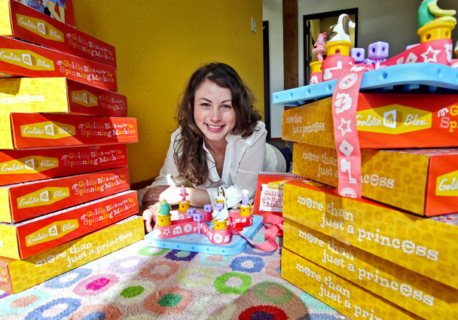
“I’m a huge fan of YouTube and I’ve seen how YouTube has launched independent musicians. They’re using YouTube to reach a new audience.”
“We’re entrepreneurs, we’re talking about being innovative so selling Kobe’s air, I’m all behind it.”
“I get a text messages from my father that’s a bunch car emojis only. It’s such a genuine way of expression.”
“I’m lucky to have a lot of positive strong role models in my life—especially my wife, Debbie Sterling, my boss.”
“Engineering has a branding problem. Too many people think of trains.”
“Only 14% of engineers in the US are women. Is it something that’s socialized.”
“Girls start to lose interest in math and science by age 7.”
“Debbie took a walk into the ‘pink aisle’—a sea of princesses and ponies.”
“The problem with dolls and ponies becomes the norm of what girls have for role models as opposed to the boy aisle.”
“Boys start developing spatial skills while playing with these toys. Debbie’s hypothesis was this has to be affecting girls too.”
“In order to get girls interested we created a personal story in our construction toys.”
“You have to be crazy to run a business with your spouse. For Debbie and I we’re very fortunate because we compliment each other. She is absolutely the CEO.”

“Running a business together accelerates communication because we’re together 24/7. It’s been stronger for our marriage.”
“I ran operations and product and Debbie ran the vision, face and marketing of the brand. Now we overlap in the creative ideas.”
“Video has been a wonderful storytelling medium. We combine story with building in GoldieBlox so we do the same with marketing.”
“If you have the right message and get it into the right hands it can go viral.”
“Debbie created a prototype and we wondered how to get the story out there so we went to Kickstarter.”
“Our first video was Debbie’s very personal story.”
“Women in engineering make 33% more than women in other fields.”
“All of these influential people showed up to bat for us and our video went viral. We reached our goal in 4 days. Toys R Us called us.”
“The buyer at Toys R Us, who has daughters, called Debbie and asked for her help figuring out the problem.”
“Here we are, we have a tiny single product in a wall of pink. What can we do—we made another video.”
“We wanted to tell the story of girls who are powerful. We got the Marin Girls Choir to sing ‘We Are the Champions.’”

“We think you can be a princess, you just need to learn how to build your own castle.”
“We were the first small business to have an ad in the SuperBowl. A million views later, we had found our core strategy.”
“Small Business, Big Game was a competition to get an ad into the SuperBowl. We wanted to get our message out and try to win the competition.”
“We put together another campaign that showcased the creativity of engineering for girls and how the princess culture toys could be integrated.”
“The girls in the video were actual Kickstarter backers’ daughter building a Rube Goldberg machine out of stereotypical girl toys—strollers, baby dolls, etc.”
“We’re making things that are for 7 year old girls and we’re not 7 year old girls. Every week we have play days for the girls to show us what is terrible.”
“With GoldieBlox we’re construction toys with books, we’ve done apps, we’re working on cartoons.”
“We’re the alternative of what Disney’s done for the princess.”
“Believe in yourself. There will be plenty of reasons why things look like they’re impossible. Don’t listen to those things.”
“We make construction toys for girls and LEGOS makes the best construction toys in the world so we’re constantly playing with their toys to learn.”
Join ‘Dot Complicated with Randi Zuckerberg’ next Wednesday at 12pm ET when Erica Keswin joins the show to discuss how to translate motherhood skills to the boardroom for our Mother’s Day Special!! Only on SiriusXM Business Channel 111.
April 22, 2016
Change In Our Pocket: Harriet Tubman on the $20
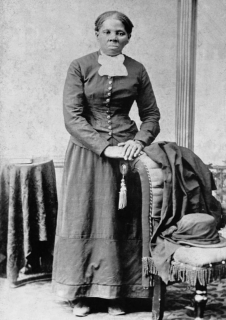
Score one for the fore-mothers of America as earlier this week the US Treasury Department announced Harriet Tubman will now replace President Andrew Jackson on the $20 bill. Discussion of this change has been in the works for awhile, from everything to a vote of which woman should be on the bill to which bill would be replaced. The original plan was to replace Alexander Hamilton on the $10 but with the Pulitzer-Prize winning success of “Hamilton” on Broadway, the switch was made.
Harriet Tubman is one of the most important figures in slavery abolitionism. She was a self-emancipated slave who led hundreds of slaves to their own freedom through the Underground Railroad. She’s not only the first woman to appear on US currency in over 100 years (as the last time a woman was on a paper note was in the late 1800s, when First Lady Martha Washington appeared on the $1 silver certificate), Tubman is also the first African-American. Unbeknownst to some, Andrew Jackson actually owned slaves himself, so the decision to put Tubman on the $20 is almost one of pure karmic satisfaction—and, of course, overdue recognition.

And in recognition of women leaders in the suffrage movement, Sojourner Truth, Susan B. Anthony, Elizabeth Cady Stanton, Alice Paul, and Lucretia Mott will now be added to the backs of the $5 and $10 bills with the back of the $5 bill being totally redesigned to include opera singer Marian Anderson, Eleanor Roosevelt, and civil rights leader Martin Luther King Jr.
Big change is ahead for women in America, but this is just a start. When these monies start going toward the Equal Pay Act, then we’ll really have something to celebrate. But until then, we gladly welcome Harriet Tubman and the other world changing women to our wallet repertoire.
April 20, 2016
Radio Recap: ‘YouTuber of the Year’ Casey Neistat

YouTube phenom, Casey Neistat, truly has a rags-to-riches story to tell—one that he showcases almost daily in his widely popular vlogs, which have already garnered almost 3 million subscribers on YouTube and over 600 million views.
A director, producer, authentic brand marketer for both corporations and himself, vlogger of authentically branded narratives and advertisements like his rogue Nike “Make it Count” video, now with over 18 million views—Casey has a loyally engaged following, a line of jewelry modeled after his trademark sunglasses, his own anti-editing social media app Beme, and today, fresh from the best of social media’s Shorty Awards where Casey won ‘YouTuber of the Year’ for his innovative and acclaimed visual storytelling, he sat down with Randi to discuss it all on ‘Dot Complicated’:
“Restrictions should be tighter for drones. I exploit how nebulous the laws currently are.”
“I almost communicate entirely with emojis with my family. I think they’re a great way to express yourself”
“It’s my mandate in life that if there’s something I really want I’ll get it. Or if I want to do something I’ll do it.”
“If I could having anything in the world I’d want to be healthy until I die a very old man.”
“I’ve committed my life to realizing anything I want to do is tangible.”
“The line is so hard to define between what you share and don’t share.”
“I post 8- 10 minutes a day. Sometimes they’re about my life, and sometimes they’re not.”
“Sometimes I skim off what is the punctuation mark of my life.”
“I prefer to share ideas that are universal in life. “
“We used to play on the railroad tracks before social media and video games.”
“The only job I ever had beside being a professional filmmaker was being a professional dishwasher.
“I could take something I was thinking about and share it 7 years before YouTube. I wanted to commit my life to this.”
“I realized how elusive it is to find what you want to do so young. To be 19 and not know what you want is the norm.”
“Never a hire an employee or date a guy or girl unless they’ve worked in a restaurant.”
“My older brother got me into filmmaking. Our relationship went from editing silly videos of my 2 year old son to having HBO series.”
“All writers need is a pencil and piece of paper. I’m not a writer so I communicate with images.”
“My first big deal was making this video for a non-profit and Hillary Clinton pronounced my name wrong.”
“Van [Neistat] is an unbelievable talent and mind. His lack of discretion and following instinct is hugely inspiring.”
“I was frustrated and mad that my $400 iPod didn’t work. What I had was a camera and a computer so I made a movie about my sardonic frustration and it just popped.”
“It’s only going to become harder and harder to stand out.”
“I want to make filmmaking as egalitarian as writing.”
“Video is becoming ubiquitous. Share something that people want to hear or see.”
“I found a lot of success in mainstream media before stopping.”
“The last episodic project I did was on HBO and I ran from it. There’s no nepotism on YouTube.”
“If people want to see your stuff the numbers will go up. There’s little to hide from when it’s real.”
“Whatever is interesting or important to me, like the NYC bike lanes video. After I made the movie the NYT got in touch and gave me a tremendous opportunity to reach a larger audience.”
“I tackled everything from Bloomberg trying to pass the sugary drink law to the return policy in NYC taxis.”
“The Chatroulette movie was one of the first movies I made after the HBO show. I was obsessed like everyone was.”
“Nike is unbelievable because of their willingness to take chances.”
“I was so exhausted of the process by the third Nike video that I just took the budget money with my editor and decided to take the next plane leaving where ever.”
“I’m always open to other opportunities to reach other audiences. But why would I want to go back to a more traditional route doesn’t interest me.”
“I’m platform agnostic. I’m happy to be wherever I can reach the biggest audience in the most realistic way.”
“People look outwards, what’s in vogue, what are others doing? By the time you’ve latched onto the trend, it’s over. Ask what YOU like. Which is risky.”
“I don’t emulate other’s style. I only know how to do it my way. Put your head down. Ignore everyone else.”
“I wake up at 4 in the morning to do my edits. It’s tough but it’s infrequent. I love doing it.”
“When the cadence is that high, you lack the opportunity to dwell. I don’t get the time to stop and think. I have to post everyday.”
“Keep going, it’s the ultimate preventative measure to writer’s block.”
“The numbers are always in line with my own intuition. If I’m doing a crappy job the numbers reflect that.”
“Stop having fun. Are you doing it for fun or to do something meaningful.”
“My typical edits take between 5-6 hours. The filming throughout the day is a constant. I have to figure out what I want to share. Is there an arc?”
“Lilly Singh does close to daily vlogs all on her cell phone. They’re reaching hundreds of thousands of people everyday just using soup to nuts software.”
“Beme came from a place where I see things that interest me and I have to figure out what I want to share.”
“I wanted a platform where one could passively share without looking at your phone.”
“When you view content and you know it was made without being edited—there’s a real beauty in that. Passive sharing and sharing honestly will make the world a better place.”
“My office is my sanctuary with that organized chaos that allows me to function. I’m more efficient in my workspace than anywhere else.”
“Seeing my kids born is my proudest moment.”
“I find the most inspiration in my kid.’
“My cell phone is my favorite camera.”
“I’m getting hell for not talking about Beme on YouTube. We’re about to launch Beme on Android.”
“I love SnapChat, I love Twitter, I love Instagram. I think Facebook has gone back to being as great as it was when it first launched.”
Be one of Casey Neistat’s 3 million subscribers and follow him on YouTube.
Make sure to tune into ‘Dot Complicated with Randi Zuckerberg’ every Wednesday at 12pm ET on SiriusXM 111!
April 15, 2016
Tax Time! Are You Ready?

Tax Day has become the Christmas for identity thieves. Between visits to your accountant, working full-time, and scavenging for financial documents, we often put security on the back burner during tax season. We often don’t think about secure passwords while filing our taxes online, or the dangers of emailing your accountant financial documents containing your social security number, or know exactly who has access to your key accounts.
—
Here are a few last minute tax tips to keep your money—and hopefully your refund—safe:
—
1. Keep new accounts safe. First time filing electronically? Is your accountant using a new online tax portal? Keep track of all of your tax and financial accounts, and make sure you create a strong, unique password for each account. Better yet, add Two-Factor Authentication to make sure your data and identity remain safe….
….Which means you….
2. Beat thieves to the punch! The earlier you file your taxes, the more likely duplicate tax filings will be rejected by the IRS. SO PREPARE EARLY NEXT YEAR! Also, as a tax filer, make sure you check on the status of your refund within 24 hours after submitting your e-filed tax return. If you haven’t received your refund within 21 days of electronically filing, or in 6 weeks after submitting your paper return, contact the IRS as soon as possible.
3. For individuals or tax preparers who choose to file their taxes electronically, make sure you purchase a verified tax software program and prepare your taxes locally on your computer, not on a website. If you do choose to file your taxes online, make sure you fill out forms on a secure “https” site only.

4. To make sure your tax information is safe, do not store any tax and financial documents locally on your computer. The IRS recommends backing up important tax and financial records on an external hard drive, a CD or DVD, or on a USB drive, and stored in a safe place.
5. If you are a Certified Public Accountant (CPA) or Certified Tax Preparer (CTP), make sure to disclose your preparer tax identification number (PTIN) issued by the IRS to your clients. For tax filers looking for a tax preparer, theBetter Business Bureau (BBB) recommends asking for referrals, checking for reviews at BBB.org, and asking the preparer about his/her qualifications and credentials.
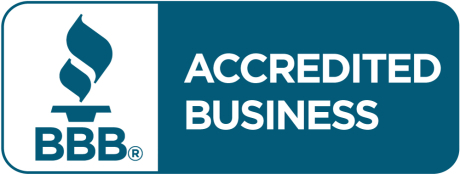
6. Do not file taxes while connected to a public Wi-Fi hotspot. While drinking coffee at your favorite coffee shop may help ease the stress of filing taxes, public wireless networks are not secure, and could easily be intercepted by snoopy hackers. Don’t risk it. Take your coffee to go.

7. ‘Tis the season to use once-a-year accounts. From part-time odd jobs to stock accounts to your retirement savings accounts, tax filers will need a tax document from several online accounts they probably only sign into once a year. Now it’s tax time and you don’t remember your passwords for them!Don’t make your password “easier” to remember. Make them strong and complex, and store them in a safe space, like a password manager. And don’t share your passwords with your accountant!
8. Social security numbers aren’t meant to be shared. When the time comes to share it with your spouse, accountant, or even your employer, make sure you share it verbally (and confidentially) over the phone, or in a secure, encrypted note.

9. Log out before you close! We’re all guilty have having several tabs open at once and forgetting to sign out of our email, social media, and other web accounts. Don’t make the same mistake when you file your taxes! Don’t risk staying logged in to a computer and someone—possibly your accountant—accessing your account just to save time.
And finally….
10. Your old files need some Spring cleaning! Make sure you and your accountant permanently delete or securely archive old files and outdated financial documents. For physical tax and financial documents, shred them if they’re no longer needed.
 By Ryan Merchant, NYC-based digital lifestyle expert with Dashlane, the leading password and identity management app.
By Ryan Merchant, NYC-based digital lifestyle expert with Dashlane, the leading password and identity management app.
April 12, 2016
April 12th = Equal Pay Day

April 12th marks Equal Pay Day—a day women have celebrated never. This date is symbolic of the amount of time it takes women’s pay to catch up with their male counterpart’s salary from the year before—even decades after the Equal Pay Act was signed into law by President John F. Kennedy in 1963.
Today, before declaring the construction of a new national monument at a historic location in Washington, D.C., to honor the movement for women’s equality, President Obama said, “I want young girls and boys 100 years from now, to come here and be astonished there was ever a time when women earned less than men for doing the same work.”
Yet in the United States, women on average are paid just 79 cents for every dollar paid to men. The average woman would’ve had to work all of 2015, and into April of 2016, just to earn as much as the average man did in ALL of 2014 alone. And factors such as race makes the disparity between men’s and women’s pay even larger. The National Women’s Law Center says that the average American woman will earn about $430,000 less than a man over a 40-year career. For Black women the losses mount to $877,480 and for Latino females they stand at over $1 million.
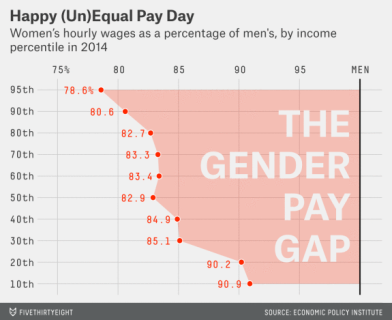
At this pace, pay equity between men and women won’t occur until 2059, and neither celebrities nor sports figures are exempt to this discrimination. Women currently represent nearly 40% of primary family breadwinners today yet are losing hundreds of thousands of dollars over their lifetimes due to wage discrimination.
WHAT CAN YOU DO?
Support salary transparency. President Obama’s very first bill signed was the Lilly Ledbetter Fair Pay Act aimed at fighting against wage discrimination and closing the gender wage gap by requiring companies with 100 or more employees to report their staff’s pay broken down by race, gender, and ethnicity to the Equal Employment Opportunity Commission (EEOC).
ASK. The VP of Human Resources for CareerBuilder says that 49% of all job candidates—male and female—didn’t ask for a raise. Negotiation’s goal is to reach an agreement ideal to both parties. You are career planning and securing job growth and potential. Work is hard, you deserve to paid appropriately for it.
Support the Paycheck Fairness Act. This proposed legislation would add procedural protections to the Equal Pay Act of 1963 and the Fair Labor Standards Act as part of an effort to address male–female income disparity in the United States. The Paycheck Fairness Act has been shot down and reintroduced many times, most recently into the United States Senate on April 1, 2014 by Senator Barbara Mikulski (D-MD)
Don’t give up! Share, post, tweet your support for women, daughters, mothers and sisters to get equal pay NOW. Fight for your children and yourself. 2059 is too long to wait.

April 8, 2016
Apply the Science of Happiness to Accelerate Success
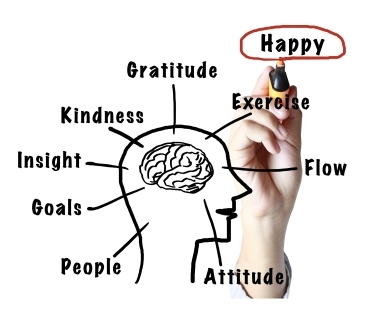
After working in many high-achieving environments like Yale, Stanford, Silicon Valley, New York City, I noticed too many people were pursuing “success” at a cost to themselves. They were postponing their happiness now in pursuit of success with the idea that, when they attain success, they will be happy. Yet they were burning themselves out (and others) in the process. I, too, joined the rat race because it seemed like what everyone was doing. It seemed like the right thing to do. But it wasn’t.
When I looked at the research, I saw that—overwhelmingly— happiness is actually the secret to success. If you prioritize your happiness, you will actually be more productive, more creative, more resilient, more energized, more charismatic and influential. You will have more willpower and be more focused, with less effort. That’s why I wrote my book The Happiness Track.
You can either listen to common (yet false!) theories of success: work yourself into the ground, stay focused on your future goals, focus nonstop, you can’t have success without stress, look out for yourself first and foremost and be your own worst critic… OR you can listen to the data which tells you the opposite: Take time off and you’ll be more innovative, stay present and you’ll be more productive and charismatic, take time to be idle and have fun and you’ll actually be more creative and more likely to have innovative breakthroughs, nurture calmness in your life and you’ll have more energy to get more work done, be kind to others and you’ll be more successful and be self-compassionate and you’ll be more resilient.

For example, we’re also taught that the only way to get ahead is to drive ourselves into the ground —one of the reasons we are seeing 50% burnout rates across industries. 70% of the US workforce is unengaged, a Gallup survey shows. We’re facing a crisis of high stress coupled with the inevitable exhaustion that comes from living an adrenaline-filled life. We are taught we’ll get more done if we’re stressed and that you simply can’t have success without stress. WRONG. What you’ll do is simply burn yourself out faster. Sure, a little stress can help get you through a deadline. But when it’s chronic, day after day, fueled by too much caffeine and a go-go-go attitude, it hurts more than it helps.
This is where exercises like breathing, yoga, and meditation come into play. They are not just a fad; they are ways you can train your nervous system to calm back down. Instead of always activating your fight-or-flight stress response, you start to strengthen the rest-and-digest calming response. With less stress, your decision-making and emotional intelligence will be better, and you will manage your energy instead. SATTVA is a popular meditation app with lots of different options.
We also believe that we should be self-critical. After all, self-criticism leads to self-improvement right? Wrong again. Research shows that self-criticism is basically self-sabotage whereas self-compassion, ie. treating yourself with the understanding, mindfulness and kindness with which you would treat a friend, leads to far greater resilience, productivity, and well-being.
 Similarly, we’re often told to look out of ourselves first and foremost. After all, we believe, it’s a dog-eat-dog world. Yet research show that being kind to others and going out of your way to help whenever and wherever you can actually ends up not only benefitting those around you but also making you more happy, healthy, and productive. Your colleagues are loyal to you, your team functions better and more productively, and the end result is a win-win for all. To nurture both self-compassion and compassion for others, try practicing loving-kindness meditation. Brain-imaging research my colleagues and I conducted at Stanford showed that even a very short 7-minute Loving-Kindness Meditation boosts your happiness and helps you feel closer to others. The meditation we used in our study can be found on the SATTVA app or on Youtube.
Similarly, we’re often told to look out of ourselves first and foremost. After all, we believe, it’s a dog-eat-dog world. Yet research show that being kind to others and going out of your way to help whenever and wherever you can actually ends up not only benefitting those around you but also making you more happy, healthy, and productive. Your colleagues are loyal to you, your team functions better and more productively, and the end result is a win-win for all. To nurture both self-compassion and compassion for others, try practicing loving-kindness meditation. Brain-imaging research my colleagues and I conducted at Stanford showed that even a very short 7-minute Loving-Kindness Meditation boosts your happiness and helps you feel closer to others. The meditation we used in our study can be found on the SATTVA app or on Youtube.
Whether you’re a business leader or a stay-at-home mom trying to keep up, the data is clear: if you take care of yourself and others, if you take time off and find joy in your life, you will be more successful at achieving your goals, not to mention fulfilled. And if you need more inspiration, let the science inspire you. Log onto sites like Fulfillment Daily to read up on the latest research on the psychology of happiness. Download the Happify app to help you implement that data into your daily life.
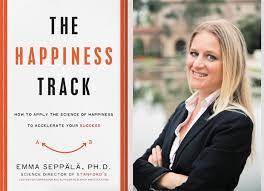 Emma Seppala is the author of The Happiness Track, and Science Director of Stanford University’s Center for Compassion and Altruism Research and Education, leadership writer for Harvard Business Review, and leading expert on health psychology, well-being, and resilience.
Emma Seppala is the author of The Happiness Track, and Science Director of Stanford University’s Center for Compassion and Altruism Research and Education, leadership writer for Harvard Business Review, and leading expert on health psychology, well-being, and resilience.
April 4, 2016
Social Media’s Impact on Modern Parenting

It’s no secret that we are living in an increasingly digital society. This is a beautiful advancement, enhancing our lives in ways unimaginable a decade ago. We use our smartphones, tablets, laptops, and other devices to log on and communicate wirelessly with our friends and family around the world. Today our cell phones are allowing us to ditch landlines and long distance plans in favor of authentic and instant communication anytime.
All of this connectivity can help forge bonds and increase family interaction, but often we walk a fine line when allowing technology to invade our lives. Our actions are sending powerful messages to our children, and if we are constantly snapping selfies or scrolling through posts we might be doing more harm than good.
The prevalence of social media in our lives has the ability to enrich our families and better our lives. However, if we fail to balance technology we can leave our children feeling left out or neglected.
With each swipe or like, we may be unintentionally sending signals to our daughters and sons that our devices are more important to them.
Several experts at the Boston Medical Center noticed this trend after watching parents and children interact in waiting rooms. These observations led researchers to conduct an anthropological study where they observed family interactions during meals at fast food chains. The data they collected found nearly 73 percent of parents used mobile devices during dinner and often appeared to “zone out” their children.
Catherine Steiner-Adair, psychologist, said, “We are behaving in ways that certainly tell children they don’t matter, they’re not interesting to us, they’re not as compelling as anybody, anything, any ping that may interrupt our time with them.”
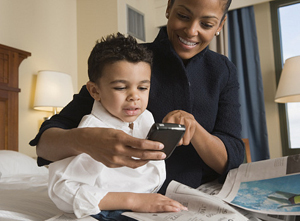
3 Reasons To Examine Our Own Social Media Use
By understanding the possible dangers, we can be proactive and more intentional with our social media usage. We all agree that social media and our devices have a time and place in our lives, but it is vital that we examine some possible side effects technology can have on our kids. By knowing the possible negatives, we can avoid these pitfalls to raise healthy and happy children.
Listed below are three common ways our love for social media can backfire on our toddlers:
Research has discovered a strong connection between parents who overuse digital devices and children who feel neglected. Constantly checking social media might be sending our toddlers the unintended message they aren’t valued enough to receive our undivided attention. Overusing devices can result in children experiencing anxiety or depression.
Heavy social media use may be robbing our children from face-to-face time with us. Studies have proven that daily interactions and conversations are crucial elements for child development. Surprisingly, the amount of words a toddler hears can impact their future successes.
Our social media use may be encouraging narcissism to develop in kids . As we document and upload our sons’ and daughters’ cuteness overloads, we are demonstrating our kids’ importance in our lives. While it’s critical to value our kids, we might be setting them up to value their self worth on likes and shares. This can develop into a lack of empathy and feelings of entitlement.

Balanced Choices: Tips To Help
With a little balance and a few intentional choices we can prevent social media from affecting our toddlers and parenting, consider the following easy solutions to limit negative side effects of social media on our toddlers:
Allow yourself a “fixed” amount of time everyday to use social media. Go ahead and indulge for thirty or forty-five minutes every day when the kidlets are down for a nap. However, when the time limit is over, power down and focus on your toddlers.
Create technology free spaces. Designate areas in the home where no phones or devices are allowed. Many families have found ideal “no technology zones” are the family dinner tables and bedrooms.
Embrace the everyday moments you have with your toddler. Take advantage of walks, car rides, diaper changes, bath times, and more. These little interactions can yield wonderful opportunities to make big memories.
Model a healthy relationship with technology. Toddlers are great at mimicking our behaviors: even the questionable ones. Lead by example, because we never know when little eyes or ears are watching.
It’s only natural to be concerned about technology’s potential impact on our parenting. Please share how you keep social media from affecting your toddlers.
 Written by blogger Hilary Smith
Written by blogger Hilary Smith
April 1, 2016
Get the Most Out of Your Mobile Devices
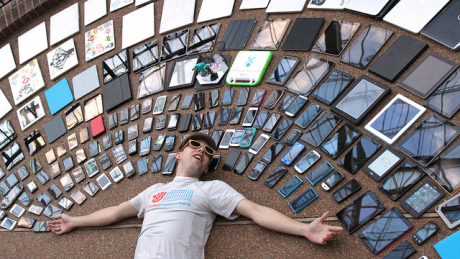
Do you ever feel like your smartphone is too smart for its own good? Or wish you could do more with your tablet than watch Netflix? Lucky for those of us who don’t find mobile devices all that intuitive, it’s actually very easy to get the most out of devices like phones, tablets and smartwatches. All it takes is a little know how.
Here are just some of the ways you can optimize your own mobile experience – most of which involve nothing more than tweaking settings or downloading an app or two.
Know your device. What operating system does it use and how much storage space is on the device itself? If you’re an Apple fan, which generation device do you have? Are you using any cloud-based storage? Take the time to browse your device’s settings to find answers to these questions. Why? Because when you know the basics, it’s easier to learn more.
Decide what you’ll be using your device for. We all use our devices for different things: gaming, learning, listening to music, streaming movies or television, etc. Do some research to find out which devices come with the features most relevant to your needs. It may be more beneficial to use an Apple device if you like the usability of iOS. But if you’re a gamer or Netflix junkie that wants a device with the best mobile processors and highest quality graphics for the ultimate visual experience, you should consider an Android device that features a Snapdragon processor.
Keep your device’s OS up to date. First, these regular updates address new security vulnerabilities, so ignoring them puts your devices at risk. And second, updating as updates become available will give you a glitch-free experience.
Play with your device’s settings. There’s almost nothing the average user can do to damage a device simply by experimenting with settings, and you may find new opportunities to customize your user experience.
Try new apps. There are vast libraries of games out there, but check out apps designed to keep your devices safe, too. LastPass, for example, creates complex passwords. And Avast! Mobile Security & Antivirus is one of the most comprehensive free security apps around. Just be careful and only download from reputable vendors. Rogue apps are a real threat.
Back it up to the cloud. You can back up just about everything to cloud storage and it won’t cost you much. If you’re using more than one cloud storage service, Unclouded lets you access files from Dropbox, Google Drive, Box and OneDrive via a single UI.
Optimize your device for nighttime. Apps like Twilight adjust your screen brightness and color settings with the sun cycle, filtering the wakeful blue light emitted by smartphones and tablets after sunset. That way, you can still check Facebook before bed without it interfering with your sleep cycle.
Use HDR mode when taking photos. High dynamic range mode ensures that light and shadows in snapshots are evenly exposed by taking two or more photos of varying exposures and combining the best parts of each into a single photo.
Use your device like an external hard drive. Most mobile devices can function like any other form of external storage. Plug it into your computer and it should show up as an external drive that you can explore. Not only can you take files off of your device, but you can also use your phone or tablet to bring files with you in place of a memory stick.
Of course, that’s just a sampling of what anyone can do to have a better mobile experience. Depending on how deep down the enhancement rabbit hole you want to go, you can things like digitize documents with scanner apps and use your device to control a smart home or create a totally custom interface. All it takes is time, research and some experimentation!
 Jennifer Thayer is an editor @FreshlyTechy and a freelance writer who loves covering technology, sports and traveling. freshlytechy.com
Jennifer Thayer is an editor @FreshlyTechy and a freelance writer who loves covering technology, sports and traveling. freshlytechy.com





